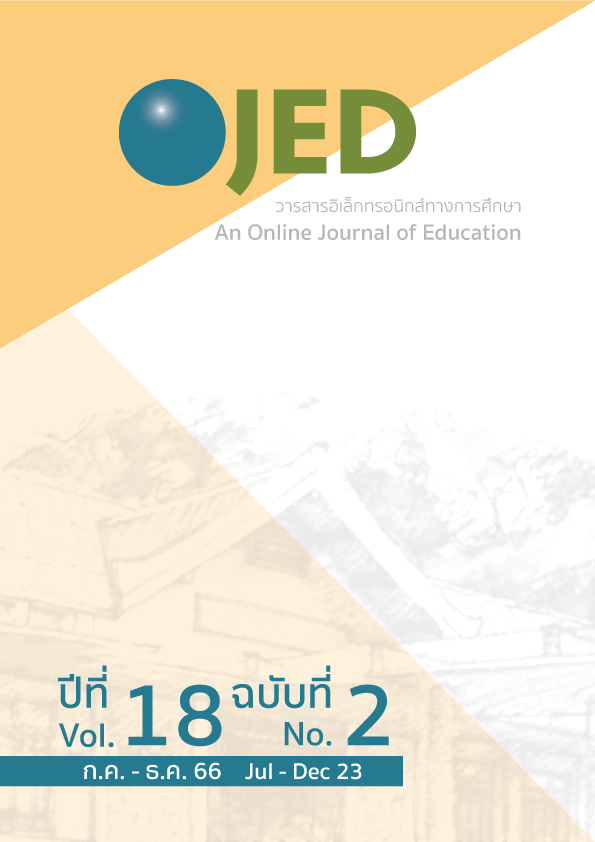Extensive Reading: A Reading Intervention for Chinese EFL Students with Different Reading Self-Efficacy Levels
DOI:
https://doi.org/10.14456/ojed.2023.21Keywords:
Extensive reading, reading self-efficacy, reading comprehension, Chinese EFL studentsAbstract
English language teaching in rural Chinese high schools has not only been methodologically backward, but also impractical in content and approach, it led to distract student motivation, decrease language abilities, and even diminish reading improvement. The purpose of this study was to 1) investigate the effects of extensive reading on the English reading comprehension of Chinese EFL students with low reading self-efficacy; 2) investigate the effects of extensive reading on the English reading comprehension of Chinese EFL students with high reading self-efficacy, and 3) explore Chinese EFL students’ reading self-efficacy after participating in an English extensive reading intervention. Fifty-four Chinese high school students selected by purposive sampling participated in a twelve-week mixed-methods study. The research instruments included (1) an English reading comprehension test; (2) a reading self-efficacy questionnaire; (3) a semi-structured interview, and (4) a reading log. Quantitative data from a paired samples t-test indicated that students with both low and high reading self-efficacy had significant improvements in English reading comprehension at a level of 0.05. The qualitative data also showed that the sense of achievement experienced by the students was also different for each reading self-efficacy group. Recommendations also offered how students with different reading self-efficacy levels efficaciously interacted with the extensive reading intervention.
References
References
Bamford, J., & Day, R. R. (2004, August 16). Extensive Reading Activities for Teaching Language (Cambridge Handbooks for Language Teachers) (1st ed.). Cambridge University Press.
Bandura, A. (1985). Social Foundations of Thought and Action: A Social Cognitive Theory (1st ed.). Prentice Hall.
Bandura, A. (1997). Self-Efficacy: The Exercise of Control (1st ed.). Worth Publishers.
Birketveit, A., Rimmereide, H. E., Bader, M., & Fisher, L. (2018). Extensive reading in primary school EFL.
Burrows, L. P. (2012). The effects of extensive reading and reading strategies on reading self-efficacy Temple University. Libraries].
Day, R. R., & Bamford, J. (2018). Extensive reading. The TESOL encyclopedia of English language teaching, 1-7.
Deng, Q., Choi, W., & Tong, X. (2019). Bidirectional cross-linguistic association of phonological skills and reading comprehension: Evidence from Hong Kong Chinese-English bilingual readers. Journal of Learning Disabilities, 52(4), 299-311.
Ghonsooly, B., & Elahi, M. (2010). LEARNERS'SELF-EFFICACY IN READING AND ITS RELATION TO FOREIGN LANGUAGE READING ANXIETY AND READING ACHIEVEMENT.
Gu, Y. X., & Lau, K. L. (2021, April 27). Examining the effects of integrated instruction on Chinese sixth-graders’ reading comprehension, motivation, and strategy use in reading fiction books. Reading and Writing, 34(10), 2581–2602. https://doi.org/10.1007/s11145-021-10161-6
Guide to extensive reading. (2010). Extensive Reading Foundation. https://erfoun dation.org/wordpress/wpcontent/uploads/2013/08/ERF_Guide.pdf
Jeon, E.-S., & Day, R. O. (2016). The Effectiveness of ER on Reading Proficiency: A Meta-Analysis. 28(2), 246–265.
Macalister, J. (2015). Guidelines or Commandments? Reconsidering Core Principles in Extensive Reading, 27(1), 122–128.
Naseri, M., & Zaferanieh, E. (2012). The Relationship between Reading Self-Efficacy Beliefs, Reading Strategy Use and Reading Comprehension Level of Iranian EFL Learners. World Journal of Education, 2(2), 64-75.
Nation, I. S. P., & Waring, R. (2019). Teaching extensive reading in another language. Routledge.
Renandya, W. A., Jacobs, G. M., Krashen, S., & Min, C. O. H. (2019). The power of reading: Case histories of second and foreign language readers. Language and Language Teaching, 8(1), 10-14.
Ro, E. (2016, June). Exploring teachers’ practices and students’ perceptions of the extensive reading approach in EAP reading classes. Journal of English for Academic Purposes, 22, 32–41. https://doi.org/10.1016/j.jeap.2016.01.006
Suk, N. (2016, February 12). Teacher and Student Perceptions of Extensive Reading Activities. The Modern English Society, 17(1), 69–88. https://doi.org/10.18095 /meeso.2016.17.1.04
Suk, N. (2016, June 25). The Effects of Extensive Reading on Reading Comprehension, Reading Rate, and Vocabulary Acquisition. Reading Research Quarterly, 52(1), 73–89. https://doi.org/
1002/rrq.152
Sun, X. (2022a). Scaffolded extensive reading: a case study of an extensive reading programme in China. Education 3-13, 1–12. https://doi.org/10.1080/0300 4279.2022.2119092
Sun, X. (2022b). Scaffolded extensive reading: A concept drawn from two EFL reading programmes. Language Teaching Research, 136216882211412. https://doi.org /1 0.1177/13621688
Tremblay, P. F., & Gardner, R. C. (1995). Expanding the motivation construct in language learning. The modern language journal, 79(4), 505-518.
Yamashita, J. (2015). In search of the nature of extensive reading in L2: Cognitive, affective, and pedagogical perspectives.
Downloads
Published
How to Cite
Issue
Section
License
Copyright (c) 2023 An Online Journal of Education

This work is licensed under a Creative Commons Attribution-NonCommercial-NoDerivatives 4.0 International License.




